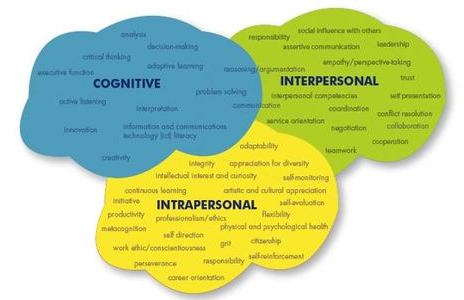“Students can’t learn in an absence of feedback,” Pellegrino said. “It’s not just assessing, but providing feedback that’s actionable on the part of students.”
HOW TO SUPPORT DEEPER LEARNING THROUGH POLICY
In order for deeper learning to become the norm rather than the exception, it has to be a priority for local, state, and national policy makers, said Linda Darling-Hammond, professor of education at Stanford and advocate for education reform. Common Core State Standards, which begin to push towards critical reasoning and problem solving and application of knowledge, are only being applied to math and literacy, he said. “What about other subjects?”
 What’s more, social-emotional skills have to be taken into account whenever we address deeper learning, he said. Some states have developed standards for social emotional skills, and it could be a good strategy for others to follow as well.
What’s more, social-emotional skills have to be taken into account whenever we address deeper learning, he said. Some states have developed standards for social emotional skills, and it could be a good strategy for others to follow as well.
The way to achieve deeper learning is through curriculum and instruction, in assessments, and teachers’ professional development, she said.
The curriculum schools use now was created by a 10-member committee of men in 1893, Darling-Hammond said. “We need a new committee,” she said. “Maybe with women and people of color, and maybe even with 20 people.”
The curriculum should go deeper into the application of skills, cover several topics that are more carefully selected and more deeply taught, and she said Common Core tries to do this. She repeated the mantra of many progressive educators: “Teach less, learn more.”
As for assessment, Darling-Hammond said our goals must be far more ambitious than they are now. Policymakers should follow the leaders of schools that have been using digital portfolios and projects as assessments, rather than relying on standardized tests. “Students are able to take feedback and revise their work,” she said. “Their conscientiousness is tested. We know that in contexts like that, we have evidence that students are doing it through college in higher numbers.”
Our current standardized tests focus on recall of facts and procedures, the lowest levels of types of learning, Pellegrino added. “They’re easily scored and quantified accountability for procedures. They’re not optimal in measuring the kinds of competencies that represent deeper learning,” he said.
But in order to use assessments that are valuable to students, we need to invest more money and time. “The kinds of tasks we need to assess take kids more time to enact and more time to score,” she said. Currently, the US spends $10 to $20 per child on assessments, but in other countries where kids are doing deep inquiries and investigations, assessments cost about $200 per student.
“We need to rethink the way we make those investments, as part of our policy agenda,” he said, because, as Pellegrino put it, what gets tested governs what gets taught.
Another big component of deeper learning involves collaboration, she said, and “collaboration is not cheating… it’s part of problem-solving. Collaboration is a skill not a deficit.”
Professional development is another key part of bringing deeper learning to students. School principals, who play a big role in curriculum adoption, as well as educators, must learn about problem-solving, child development, and content pedagogy in order to understand how to set up collaborative and project-based learning.
But in order to do their jobs well, educators must be given enough time to create a thoughtful curriculum. In other countries, Darling-Hammond said, educators are allotted 15 to 20 hours a week just dedicated to curriculum creation.
For those interested in pursuing deeper learning strategies in class, she suggested pulling out the key ideas from current standards and going deep into those subjects, such as ratio and proportion in math. She also suggested reading books and learning more about complex instructions and how to develop collaborative group work, even in classes where there’s a wide range of student skills.
BYPRODUCT OF DEEPER LEARNING
From an Edweek article that reported on findings from the same study:
The committee pointed to one 2008 five-year longitudinal study of 700 California students in three high schools: one urban and one rural school, each with a large proportion of minority and English-language learner students, and another overwhelmingly wealthy, white school. While at the start of the study, incoming 9th graders in the diverse urban school performed significantly below the students in the other schools in mathematics, the school designed its algebra and geometry courses to highlight multiple dimensions of math concepts and approaches to problem-solving, self- and group-assessment and developing good questions. When tested at the end of the first year, the students exposed to the “deeper learning” math had caught up with their peers in algebra, and they performed significantly better than students in the other schools in the following year. By the 4th year of the study, 41 percent of students at the urban diverse school were taking calculus, in comparison to only 27 percent at the other two schools.
The study was partially funded by the William and Flora Hewlett Foundation.